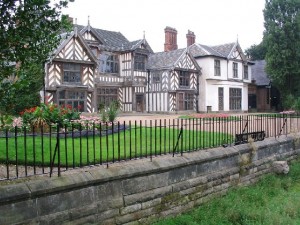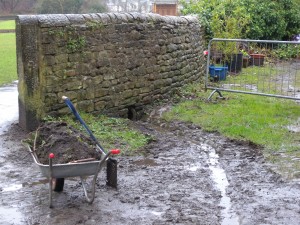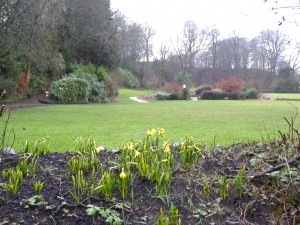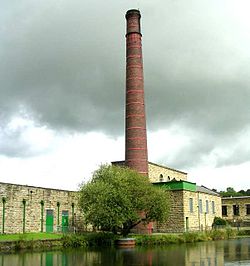Fire at Wythenshaw Hall, Manchester
CLICK HERE for latest report and video.
 © Copyright Dave Smethurst and licensed for reuse under this Creative Commons Licence
© Copyright Dave Smethurst and licensed for reuse under this Creative Commons Licence

Museum, Tea Room, 18th Century Walled Garden
CLICK HERE for latest report and video.
 © Copyright Dave Smethurst and licensed for reuse under this Creative Commons Licence
© Copyright Dave Smethurst and licensed for reuse under this Creative Commons Licence
It’s in Lancashire… but they don’t say where… CLICK HERE
A major fund-raising appeal has been launched to restore or replace every mile marker along the length of the Leeds and Liverpool Canal – all part of the canal’s 200th anniversary celebrations. Click Here for more…
Alex gave an excellent talk and update this evening about the Archaeology Group’s Hidden Valley Project. The Hidden Valley runs from Sabden area through to Blacko and is hidden by Pendle Hill to the north and the much lower Padiham to Barrowford ridge to the south. Alex concentrated on the activities, finds and discoveries of the last year and it was striking how great a timescale is represented in the valley, from Mesolithic finds through to World War Two structures. The audience entered into the fun of discovery, trying to work out what certain objects and structures were actually used for. All sorts of activities took place in the valley and we were treated to Tudor era quarrying, Napoleonic Yeomanry Musket Practice and prehistorical knapping sites, to name three before Alex looked forward to this year’s activities. Here are one or two of the many slides…
CLICK HERE for Lancashire Telegraph article.
Another loss to Burnley’s Weaver’s Triangle – click here for details.
Sawley Abbey, which is managed by Heritage Trust for the North West, is undergoing a steady programme of conservation by English Heritage. This trial and error approach is often the best way to do things but is not always possible for site management reasons. Experimental repointing and stabilization was followed by soft topping the walls with turf to absorb rainfall more slowly and protect the tops of the walls. There is now extensive repair and lime repointing taking place of the lower parts of the walls. Because of the time of year, the work is shielded by large hessian sheets hung over the work to protect it from premature drying out and/or freezing.
If you are interested in the conservation skill of lime repointing, there is a half day course at the heritage centre on the 5th March. CLICK HERE for details.
For earlier posts on the conservation work, CLICK HERE.
The Friends Chairman, David Morris, gave an illustrated talk on the Pendle Heritage archaeology group’s research on the enclosures and vaccaries of the Pendle and Trawden Forests to the Upper Wharfedale Field Society. Around fifty people came to the Octagon, Grassington and the event was friendly and enjoyable. It was a good time to renew some old acquaintances.
Archaeologists are using Environment Agency laser mapping data to rediscover hundreds of kilometres of ‘lost’ Roman roads.
Since 1998 the Environment Agency has used lasers to scan and map the English landscape from above to help with work such as flood modeling and tracking changing coastlines. But these LIDAR (Light Detection and Ranging) data are also publicly available and have been used to help with everything from building virtual worlds to managing forests. In particular, it is helping to find lost Roman roads across the north of England. Click Here for the article.

The gardening group was rained off for not the first time this winter. However, there is one job that benefits from rain and soggy ground. This is the clearing of grass and vegetation off cobbles as the water loosens the roots. So we had a ‘set-to’ on the cobbles against the raised planter bed we tackled earlier. The cobbles had been made worse recently by silt from the flooding over the Christmas period. We got a few hours in and cleared the worst. It next needs troweling between the cracks and a brush down, but we’ll do that when its a bit drier!

The Knutsford and Malpas Hoards are on display at Museum of Liverpool until 19th June, Click Here for more information.
 Why is London’s Garden Bridge worth as much as five Lancashire museums? Ask Joanna Lumley
Why is London’s Garden Bridge worth as much as five Lancashire museums? Ask Joanna LumleyThe cultural shockwaves of the closure of the 5 Lancashire museums continues and, in this article, the issue is compared with what some see as a London vanity project, the cost of which would keep the Lancashire museums going for half a century. CLICK HERE for the article.
After cuts forced Bradford to send its photo archive to London last week, battle lines are being drawn on the future of key museums outside the capital. CLICK HERE for story.
CLICK HERE for latest update on this exciting dig.
 Downfall of a political giant: Inside the eerie ruins of Britain’s biggest Conservative Club where the elegant ballroom and grand staircases are crumbling to dust.
Downfall of a political giant: Inside the eerie ruins of Britain’s biggest Conservative Club where the elegant ballroom and grand staircases are crumbling to dust.
The Accrington Conservative Club building is a desolate shell in the town, near Blackburn, Lancs
The building was the largest Conservative Club in the country when it first opened its doors back in 1891
Once celebrated for its grand ball room which hosted parties of up to 1,000 people, it now lies empty and decrepit
The building was converted into a nightclub in the 1990s, but it closed in 2003 after a customer was killed outside
Since then it has had multiple renovation plans rejected and narrowly avoided plans to have it partially demolished
Read the rest and view a set of photos – click here
One of Blackburn’s most iconic buildings, the Cotton Exchange, is to be transformed into restaurant, bar and theatre. Click here for the story and a set of photos.
Read more: http://www.lancashiretelegraph.co.uk/news/14241108.MP_battles_on_to_save____treasure___/